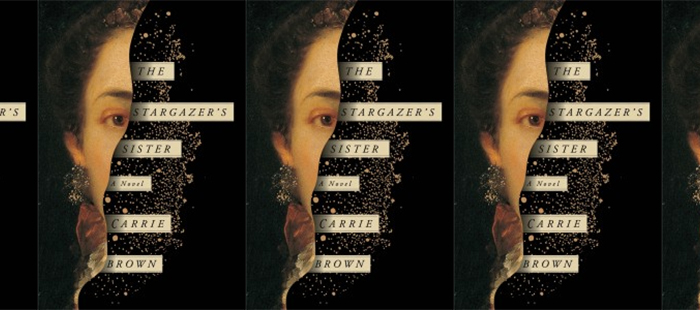Review: THE STARGAZER’S SISTER by Carrie Brown

The Stargazer’s Sister
Carrie Brown
Pantheon, January 2016
352 pp; $25.95
Reviewed by Ellen Birkett Morris
Here it is, the moon that has followed her everywhere through her childhood—racing between treetops to find her, darting over rooflines, appearing suddenly in the river at her feet or reflected in the barrel in the courtyard when she bent to rinse her face … Since childhood she had always thought of it as William’s moon, as if he had invented it. Certainly she has always felt connected to him by it. Wherever they were, no matter how far apart, the same moon looked down on them.
The trick of creating compelling fiction is putting the reader in the character’s skin, conveying lived experience in such a way as the reader feels it. This is perhaps even more important for historical fiction, where simple aspects of life might be unfamiliar to the reader. Novelist Carrie Brown achieves this sort of prose magic in her latest novel, The Stargazer’s Sister. The novel artfully spans the lifetime of Caroline Herschel, sister of composer and astronomer William Herschel.
The story is grounded in physical and sensory details that bring to life Caroline’s world, such as this passage about a childhood illness that leaves Caroline weakened and with a pockmarked face:
There is pain in her body, but she cannot locate its source. It seems to be everywhere.
Then she hears William’s voice nearby, and she wants to say his name, but it is as though she has dropped away from her own body down into a deep well. She tries to call out to him, but her voice makes only a little disturbance in the air above her head, a visible rippling, like a lizard’s streak of a blue tail. The whisper of sound slides away into the silence and darkness and is lost.
The focus of the story alternates between the trials of her life and the bond shared by siblings as they purse a love of astronomy, often side by side. The reader is privy to Caroline’s childhood of abuse and illness, her loneliness in spite of her closeness to her brother, and her unrelenting labor (working day and night) in service of his work as an astronomer. As with Anthony Doerr’s All the Light We Cannot See, the beautiful rests alongside the sad providing a complex, interesting portrait of a life.
Around them, The night sky: resplendent, royally decorated, assemblies of stars stepping forth. For all that, though, it is the darkness she feels.
Caroline’s story is appealing, in part, because she overcomes childhood illness, lack of beauty and her low status as a woman of few means with curiosity, tenacity and ingenuity. She manages the household, aids in the construction of a forty-foot telescope and helps her brother scan the skies at night. She is an unlikely heroine who transcends her own sadness and fear to help further the field of astronomy. She aids in her brother’s discoveries and, ultimately, makes one of her own.
The comet appears to her on the third night, She sweeps as far as Beta Lyrae, and then there it is, coming from the south, surrounded by a burr of light. Though she has seen William’s comets, she feels now as she did on her first glimpse of the moon through a telescope on the deck of the packet that brought them to England … She understands now, as she did not on that first night on the ship, the time the universe contains, the depth of history truly beyond her comprehension.
The book’s prologue is titled “Let Whatever Shines Be Noted,” the motto of the Royal Astronomical Society. This phrase serves as an apt metaphor for Caroline’s character, the numerous astrological discoveries of Caroline and William, and Brown’s telling of this captivating story.
Ellen Birkett Morris’s interviews and book reviews have appeared in Prairie Schooner, Electric Literature, The Rumpus, Best New Fiction and Authorlink. Her fiction has appeared in Shenandoah, Antioch Review, Notre Dame Review, South Carolina Review, wigleaf, and Santa Fe Literary Review.



